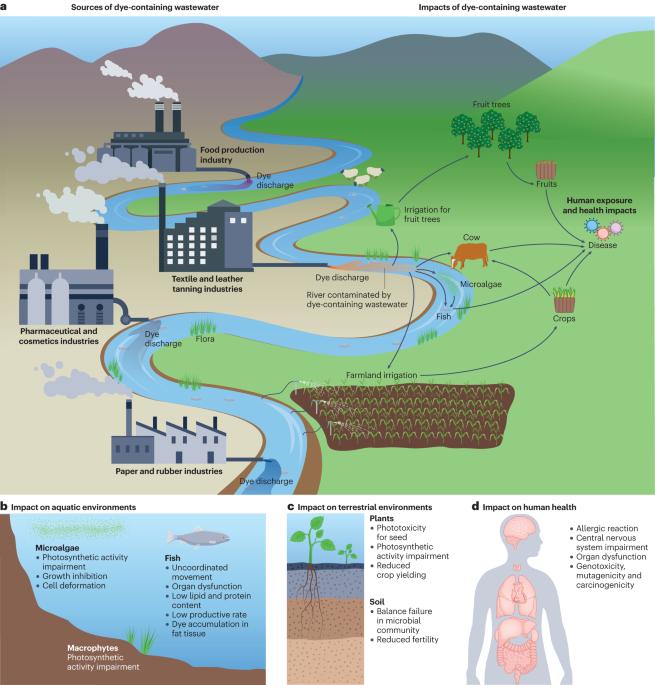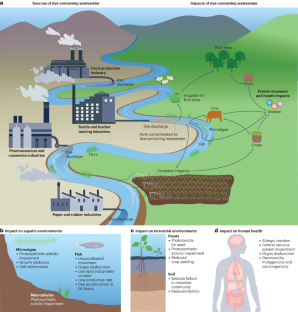Environmental impacts and remediation of dye-containing wastewater
引用次数: 0
Abstract
Synthetic dyes are used in various industries including textile processing, food production and the pharmaceutical sector. Yet, approximately 80% of the dye-containing wastewaters produced are often released untreated into waterways or used directly for irrigation, causing detrimental impacts on human health and ecosystems. In this Review, we discuss the environmental impact of dye-containing wastewater and explore the chemical, biological and physical mitigation strategies used to treat and decontaminate dye-containing wastewaters. Untreated synthetic dyes cause coloration of receiving water bodies, hindering the degree of visible light reaching the photic ozone, and have carcinogenic, mutagenic and teratogenic properties that have toxic impacts on plants, animals and humans. Chemical treatment methods such as coagulation are the most widely adopted treatment methods; however, they require careful sludge management to be effective. Biological degradation, involving the implementation of enzymes, microorganisms and plants, is an environmentally friendly and energy-efficient approach for dye degradation, but it requires lengthy reaction times and the use of selective bio-organisms for target dyes. Advanced membrane-based physical separation can achieve effective removal of dyes and inorganic salts from highly saline dye-containing wastewater, while also enabling their recovery and reuse. Strengthened regulatory requirements and development of non-toxic dyes are required in conjunction with these remediation treatments to effectively mitigate dye-related pollution. Wastewater dyes from textile, food and pharmaceutical industries are a major environmental concern. This Review discusses the environmental impacts of dye-containing wastewater and explores both conventional and emerging remediation strategies.


含染料废水对环境的影响和补救措施
合成染料广泛应用于各行各业,包括纺织加工、食品生产和制药行业。然而,所产生的含染料废水中约有 80% 通常未经处理就排放到水道中或直接用于灌溉,对人类健康和生态系统造成有害影响。在本综述中,我们将讨论含染料废水对环境的影响,并探讨用于处理和净化含染料废水的化学、生物和物理缓解策略。未经处理的合成染料会导致受纳水体变色,阻碍可见光到达光臭氧的程度,并具有致癌、致突变和致畸特性,对植物、动物和人类产生毒性影响。混凝法等化学处理方法是最广泛采用的处理方法,但需要对污泥进行仔细管理才能有效。生物降解涉及酶、微生物和植物的使用,是一种环境友好且节能的染料降解方法,但需要较长的反应时间,并对目标染料使用选择性生物有机体。先进的膜物理分离技术可以有效去除高含盐染料废水中的染料和无机盐,同时还能实现回收和再利用。在进行这些修复处理的同时,还需要加强监管要求和开发无毒染料,以有效缓解与染料有关的污染。纺织、食品和制药行业的废水染料是一个主要的环境问题。本综述讨论了含染料废水对环境的影响,并探讨了传统和新兴的补救策略。
本文章由计算机程序翻译,如有差异,请以英文原文为准。
求助全文
约1分钟内获得全文
求助全文

 求助内容:
求助内容: 应助结果提醒方式:
应助结果提醒方式:


